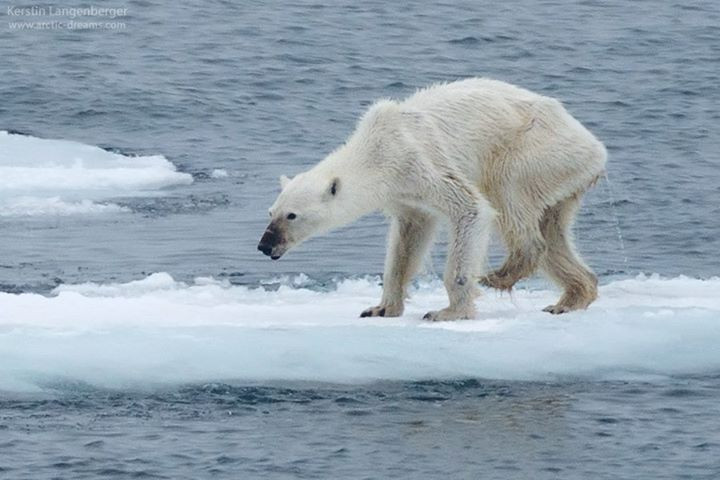Svalbard: Shocking picture shows emaciated polar bear 'doomed to death'

A photograph of an emaciated polar bear on the Norwegian archipelago of Svalbard has sparked debate over global warming. The image, taken by photographer Kerstin Langenberger, shows an injured female polar bear, which she says is now a fairly common site for the area.
In a blog about the picture, she said Svalbard has always been seen as one of the most accessible polar bear populations on the world, with the species being well protected. However, she said the true situation is far less encouraging: "I see the summers being so pleasant (and warm) as never before.
"I see the glaciers calving, retreating dozens to hundreds of metres every year. I see the pack ice disappearing in record speed. Yes, I have seen bears in good shape – but I have also seen dead and starving polar bears. Bears walking on the shores, looking for food, bears trying to hunt reindeer, eating birds' eggs, moss and seaweed."
She said while males often appear a healthy weight, females fare far worse. They are often slim and get stuck on land where there is not much food. "Only few times I have seen beautifully fat mothers with beautifully fat young," she wrote. "Many times I have seen horribly thin bears, and those were exclusively females – like this one here. A mere skeleton, hurt on her front leg, possibly by a desperate attempt to hunt a walrus while she was stuck on land."
Langenberger said it is difficult to imagine the polar bear population of Svalbard is stable as there are fewer females and cubs, or if they consistently appear to be underweight or starving: "Only once I have seen a bear getting a big fat five [on the body index scale], but several times I have seen dead bears and bears like this one: a mere one on the scale, doomed to death.
"I do not have scientific data to proof my observations, but I have eyes to see – and a brain to draw conclusions. Climate change is happening big deal here in the Arctic. And it is our decision to trying to change this."
The image on Langerberger's Facebook page has been shared more than 41,000 times, with many saying urgent action is needed to protect the species. However, some experts have said it shows only a snapshot of the true picture of the Svalbard populations. Iain Stirling, from the University of Alberta, said the bear picture could be sick or old – and is not necessarily dying from the effects of climate change
"You have to be a little bit careful about drawing conclusions immediately," he told Mashable. "[The bear] may be starving, but it may just be old. A difficulty hunting could be involved. I don't think you can tie that one to starvation because of lack of sea ice."

Regardless of why the polar bear was dying, the image highlights problems facing populations of the species worldwide. A study published in the journal Science in July found polar bears cannot make up for summer food deprivation by entering a "walking hibernation".
Previously, scientists had said polar bears forced ashore – where feeding opportunities are extremely limited – can make up for the restricted foraging by entering a low energy state that helps them survive the lean months.
The team, from the University of Wyoming, found this is not the case and instead spend a huge amount of energy in the summer months. They captured more than 20 polar bears and implanted temperature loggers and tracking devices to monitor their movements on shore and the ice between 2008 and 2010.
"We found that both core temperature and activity remained above values observed during winter hibernation," the authors wrote. "The gradual declines in core temperature during summer suggest a typical mammalian response to fasting, which offers limited to no energy savings based on mass-specific metabolic rates.
"Thus, our data indicate that bears cannot use a hibernation-like metabolism to meaningfully prolong their summer period of fasting and reliance on energy stores."
Similarly, another study from April found polar bears cannot sustain their diets with food foraged on land as sea ice retreats further. Published in the journal Frontiers in Ecology and the Environment, said any gains from terrestrial foods like berries and birds cannot make up for that found in the sea, so cannot be seen as a long-term solution for their survival.
Lead author Karyn Rode told IBTimes UK: "The conclusion was that there isn't very good evidence to suggest that they're feeding more on terrestrial foods than they have in the past. They're eating some things but it's not contributing enough at a population level – even for an individual population. The contribution of terrestrial foods when they're on shore is not enough to offset the effects of sea ice loss."
© Copyright IBTimes 2025. All rights reserved.






















